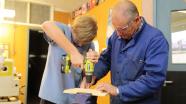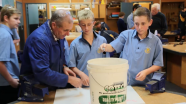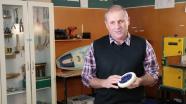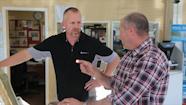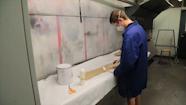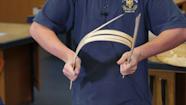Finding materials to meet the specs
Steve Andrew shares how students identify material specifications in a brief and then test materials to find those that are suitable. The students are involved in practical learning experiences that grow their understandings of the properties of materials.
Duration: 02:36
Transcript
It’s really important in our school that we give our students these practical experiences. And the using of the technological products or the reading of them and the playing with them we found is so important.
When we move on to applying this sort of thinking to our projects, we generally work from a brief. We try and identify some basic material specifications in our brief. That gives our practice depth. And from then on we keep those material specifications in mind, which could be things like the environmental resistance of the material, or the strength of the material, or the colour of the material. And we keep that in mind, and then we just get a selection of materials for our boys to play with.
So, once again, it's this tactile thing where they’ve got them in their hands – we let them drill holes in them, we let them bend them. They come and ask us questions about them – “Sir can I bend this?” And at times I might say, “Well, I’m not too sure. You go and try it and come back and tell me what the answer is.”
The technology curriculum, the teacher guidance notes in there actually promote this sort of teaching – the hands-on experimenting with materials, drilling holes, bending, breaking, playing with the stuff. They enjoy that. They learn so much. They learn about the material, they learn how they can manipulate it, and at times they even come back with information that is new to me as well. So I think that’s really important.
These learning experiences, especially at junior level, they generally only last for about a period. They’re not too involved and they go away in groups and they do these and then they write them up. So, for instance, if they are playing with aluminium, they’ll come back to me and they’ll say, “Sir, the aluminium’s nice and soft, I can bend it easy, I can drill it easy, we can put texture on it.” So they write these things down so they’ve got a record of that to use in their practice when they are developing their product.
Once they’ve learnt about those materials, then they can start to apply that knowledge that they’ve learnt to the making of their project. Because if, say for instance the weather station that they make, if they know that they can cut fine shapes in it, or they can polish the edge of it, or they can, they can put texture on it, then it’s going to improve the quality of the product that comes out. And you know that is to me much deeper learning than just handing them the materials and saying, “We’re going to use this today because it’s got a smooth surface on it.” But by them having a total understanding of what we can do with, it gives them this depth of understanding for their project.
Curriculum links
The structure of technology in the NZC
Follow the link below to view a diagram showing the structure of the strands and components within technology:
Indicators of progression and teacher guidance
Steve Andrew talks about the teacher guidance given for technology. Teacher guidance for each component within the technology curriculum is given with the indicators of progression. These indicators provide detailed information about what students need to be able to know and do in relation to the achievement objectives for technology.
Follow the links below to read the indicators and teacher guidance for brief development and technological products.
Reflective questions
- What opportunities do I give students to play with materials to discover their performance properties?
- What opportunities do I give students to discuss and develop material specifications for their products?
- How can I support students to use the correct vocabulary for the performance properties of materials?
Related resources
Resources
- Strategies for teaching technological products: A variety of strategies are used to introduce year 6 and 7 students to the concepts of performance properties.
- Bitesize testing the properties of materials: This online resource introduces the properties of materials.
- Exploring food packaging: Exploring Māori food packaging as well as other food packaging helped students to understand the concepts within the technological products component.
Technology in the news
- Forestry meets Industry 4.0: A glue-laminated timber is created to specifications using sensors, artificial intelligence, and robotics.
- Why Tesla's weird, new Cybertruck could be a hit: Multiple material types are used in the truck but one material failed in a demonstration.
Note that you can search the news section by using the keywords under each item.
More videos
Combining knowledge and practice
In this video Steve Andrew describes how focusing on technological products gives depth to technology teaching and learning at St John's.
Linking hands-on experiences and understandings
Terry Mitchell, Steve Andrew, and their students show how making whistles from aluminium and from plastic provides a great context for discussing the properties of materials.
Play, experiment, explore
Steve Andrew shares how and why he has the students see, feel, and play with products to develop their understandings in materials.
School–industry relationship cuts both ways
Steve Andrew and Terry Rillstone describe the way the relationship between St John's College and The Shop has benefits for them both.
Pushing the boundaries with materials
Steve Andrews describes how his senior students have the confidence to select and work with unfamiliar materials.
Exploring unfamiliar materials
Two year 12 students describe what they know about bamboo and how they are applying this knowledge to their projects.

